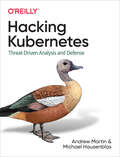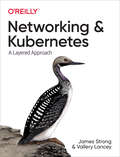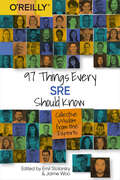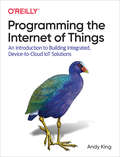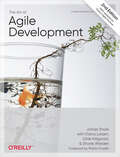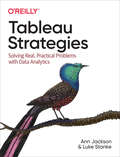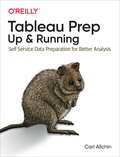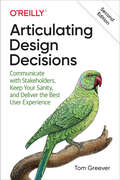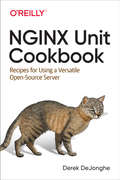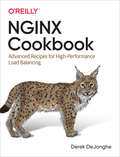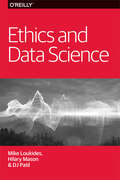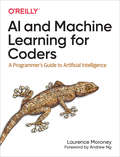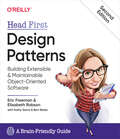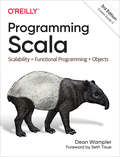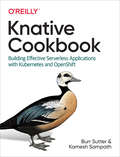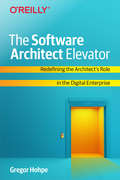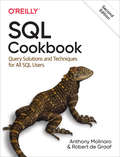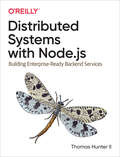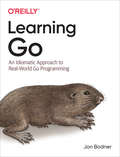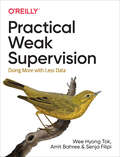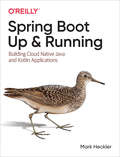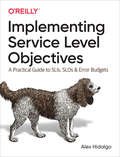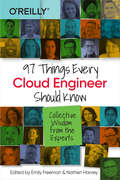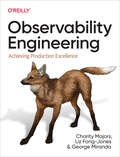- Table View
- List View
Hacking Kubernetes
by Andrew Martin Michael HausenblasWant to run your Kubernetes workloads safely and securely? This practical book provides a threat-based guide to Kubernetes security. Each chapter examines a particular component's architecture and potential default settings and then reviews existing high-profile attacks and historical Common Vulnerabilities and Exposures (CVEs). Authors Andrew Martin and Michael Hausenblas share best-practice configuration to help you harden clusters from possible angles of attack.This book begins with a vanilla Kubernetes installation with built-in defaults. You'll examine an abstract threat model of a distributed system running arbitrary workloads, and then progress to a detailed assessment of each component of a secure Kubernetes system.Understand where your Kubernetes system is vulnerable with threat modelling techniquesFocus on pods, from configurations to attacks and defensesSecure your cluster and workload trafficDefine and enforce policy with RBAC, OPA, and KyvernoDive deep into sandboxing and isolation techniquesLearn how to detect and mitigate supply chain attacksExplore filesystems, volumes, and sensitive information at restDiscover what can go wrong when running multitenant workloads in a clusterLearn what you can do if someone breaks in despite you having controls in place
Networking and Kubernetes
by James Strong Vallery LanceyKubernetes has become an essential part of the daily work for most system, network, and cluster administrators today. But to work effectively together on a production-scale Kubernetes system, they must be able to speak the same language. This book provides a clear guide to the layers of complexity and abstraction that come with running a Kubernetes network.Authors James Strong and Vallery Lancey bring you up to speed on the intricacies that Kubernetes has to offer for large container deployments. If you're to be effective in troubleshooting and maintaining a production cluster, you need to be well versed in the abstraction provided at each layer. This practical book shows you how.Learn the Kubernetes networking modelChoose the best interface for your clusters from the CNCF Container Network Interface projectExplore the networking and Linux primitives that power KubernetesQuickly troubleshoot networking issues and prevent downtimeExamine cloud networking and Kubernetes using the three major providers: Amazon Web Services, Google Cloud, and Microsoft AzureLearn the pros and cons of various network tools--and how to select the best ones for your stack
97 Things Every SRE Should Know: Collective Wisdom From The Experts
by Emil Stolarsky Jaime WooSite reliability engineering (SRE) is more relevant than ever. Knowing how to keep systems reliable has become a critical skill. With this practical book, newcomers and old hats alike will explore a broad range of conversations happening in SRE. You'll get actionable advice on several topics, including how to adopt SRE, why SLOs matter, when you need to upgrade your incident response, and how monitoring and observability differ.Editors Jaime Woo and Emil Stolarsky, co-founders of Incident Labs, have collected 97 concise and useful tips from across the industry, including trusted best practices and new approaches to knotty problems. You'll grow and refine your SRE skills through sound advice and thought-provokingquestions that drive the direction of the field.Some of the 97 things you should know:"Test Your Disaster Plan"--Tanya Reilly"Integrating Empathy into SRE Tools"--Daniella Niyonkuru"The Best Advice I Can Give to Teams"--Nicole Forsgren"Where to SRE"--Fatema Boxwala"Facing That First Page"--Andrew Louis"I Have an Error Budget, Now What?"--Alex Hidalgo"Get Your Work Recognized: Write a Brag Document"--Julia Evans and Karla Burnett
Programming the Internet of Things: An Introduction To Building Integrated, Device-to-cloud Iot Solutions
by Andy KingLearn how to program the Internet of Things with this hands-on guide. By breaking down IoT programming complexities in step-by-step, building-block fashion, author and educator Andy King shows you how to design and build your own full-stack, end-to-end IoT solution--from device to cloud. This practical book walks you through tooling, development environment setup, solution design, and implementation.You'll learn how a typical IoT ecosystem works, as well as how to tackle integration challenges that crop up when implementing your own IoT solution. Whether you're an engineering student learning the basics of the IoT, a tech-savvy executive looking to better understand the nuances of IoT technology stacks, or a programmer building your own smart house solution, this practical book will help you get started.Design an end-to-end solution that implements an IoT use caseSet up an IoT-centric development and testing environmentOrganize your software design by creating abstractions in Python and JavaUse MQTT, CoAP, and other protocols to connect IoT devices and servicesCreate a custom JSON-based data format that's consumable across a range of platforms and servicesUse cloud services to support your IoT ecosystem and provide business value for stakeholders
The Art of Agile Development: Pragmatic Guide To Agile Software Development
by James Shore Shane WardenMost companies developing software employ something they call "Agile." But there's widespread misunderstanding of what Agile is and how to use it. If you want to improve your software development team's agility, this comprehensive guidebook's clear, concrete, and detailed guidance explains what to do and why, and when to make trade-offs.In this thorough update of the classic Agile how-to guide, James Shore provides no-nonsense advice on Agile adoption, planning, development, delivery, and management taken from over two decades of Agile experience. He brings the latest ideas from Extreme Programming, Scrum, Lean, DevOps, and more into a cohesive whole. Learn how to successfully bring Agile development to your team and organization--or discover why Agile might not be for you.This book explains how to:Improve agility: create the conditions necessary for Agile to succeed and scale in your organizationFocus on value: work as a team, understand priorities, provide visibility, and improve continuouslyDeliver software reliably: share ownership, decrease development costs, evolve designs, and deploy continuouslyOptimize value: take ownership of product plans, budgets, and experiments--and produce market-leading software
Tableau Strategies
by Ann Jackson Luke StankeIf you want to increase Tableau's value to your organization, this practical book has your back. Authors Ann Jackson and Luke Stanke guide data analysts through strategies for solving real-world analytics problems using Tableau. Starting with the basics and building toward advanced topics such as multidimensional analysis and user experience, you'll explore pragmatic and creative examples that you can apply to your own data.Staying competitive today requires the ability to quickly analyze and visualize data and make data-driven decisions. With this guide, data practitioners and leaders alike will learn strategies for building compelling and purposeful visualizations, dashboards, and data products. Every chapter contains the why behind the solution and the technical knowledge you need to make it work.Use this book as a high-value on-the-job reference guide to TableauVisualize different data types and tackle specific data challengesCreate compelling data visualizations, dashboards, and data productsLearn how to generate industry-specific analyticsExplore categorical and quantitative analysis and comparisonsUnderstand geospatial, dynamic, statistical, and multivariate analysisCommunicate the value of the Tableau platform to your team and to stakeholders
Tableau Prep: Self-service Data Preparation For Better Analysis
by Carl AllchinFor self-service data preparation, Tableau Prep is relatively easy to use—as long as you know how to clean and organize your datasets. Carl Allchin, from The Information Lab in London, gets you up to speed on Tableau Prep through a series of practical lessons that include methods for preparing, cleaning, automating, organizing, and outputting your datasets.Based on Allchin’s popular blog, Preppin’ Data, this practical guide takes you step-by-step through Tableau Prep’s fundamentals. Self-service data preparation reduces the time it takes to complete data projects and improves the quality of your analyses. Discover how Tableau Prep helps you access your data and turn it into valuable information.Know what to look for when you prepare dataLearn which Tableau Prep functions to use when working with data fieldsAnalyze the shape and profile of your datasetOutput data for analysis and learn how Tableau Prep automates your workflowLearn how to clean your dataset using Tableau Prep functionsExplore ways to use Tableau Prep techniques in real-world scenariosMake your data available to others by managing and documenting the output
Articulating Design Decisions: Communicate With Stakeholders, Keep Your Sanity, And Deliver The Best User Experience
by Tom GreeverTalking to people about your designs might seem like a basic skill, but it can be difficult to do well. In many cases, how you communicate with stakeholders, clients, and other nondesigners may be more important than the designs themselves. Because if you canâ??t get their support, your work will never see the light of dayâ??no matter how good it is.This practical guide focuses on principles, tactics, and actionable methods for presenting your designs. Whether you design apps, websites, or products, youâ??ll learn how to get support from people who have influence over the project with the goal of creating the best user experience.Walk through the process of preparing and presenting your designsUnderstand stakeholder perspectives and learn how to empathize with themCultivate both implicit and explicit listening skillsLearn tactics and strategies for expressing the most effective response to feedbackCreate the right documentation for your decisions to avoid repeated conversationsLearn why following through is just as important as the meeting itself
NGINX Unit Cookbook: Recipes For Using A Versatile Open Source Server
by Derek DeJongheAlongside its popular web server, NGINX provides a dynamic application server that supports configuration through a RESTful JSON API. The open source NGINX Unit server deploys configuration changes without service disruptions and runs apps built with multiple languages and frameworks. This updated cookbook shows developers, DevOps personnel, network admins, and cloud infrastructure pros how to quickly get started with NGINX Unit.Hands-on recipes demonstrate Unit’s new approach and show you how to deploy and configure this server for different applications. You’ll learn how to run applications written in different languages on the same server, how to use NGINX Unit as the foundation for your web application development environment, and how Unit’s RESTful API simplifies configuration.Learn how Unit differs from other middleware application serversInstall Unit using source code, Red Hat and Debian systems, or third-party repositoriesConfigure Unit using application, router, and listener objectsStart and stop the Unit server and the applications it runsManage user permissions, Linux namespace isolation, and API securityRun WordPress, Django, and other web applications with UnitServe applications with an NGINX proxy or load balancer
NGINX Cookbook: Advanced Recipes For High-performance Load Balancing
by Derek DeJongheNGINX is one of the most widely used web servers available today, in part because of its capabilities as a load balancer and reverse proxy server for HTTP and other network protocols. This cookbook provides easy-to-follow examples to real-world problems in application delivery. The practical recipes will help you set up and use either the open source or commercial offering to solve problems in various use cases.For professionals who understand modern web architectures, such as n-tier or microservice designs, and common web protocols including TCP and HTTP, these recipes provide proven solutions for security, software load balancing, and monitoring and maintaining NGINX’s application delivery platform. You’ll also explore advanced features of both NGINX and NGINX Plus, the free and licensed versions of this server.You’ll find recipes for:High-performance load balancing with HTTP, TCP, and UDPSecuring access through encrypted traffic, secure links, HTTP authentication subrequests, and moreDeploying NGINX to Google Cloud, AWS, and Azure cloud computing servicesSetting up and configuring NGINX ControllerInstalling and configuring the NGINX Plus App Protect moduleEnabling WAF through Controller ADC
Ethics and Data Science
by Mike Loukides Hilary Mason Dj PatilAs the impact of data science continues to grow on society there is an increased need to discuss how data is appropriately used and how to address misuse. Yet, ethical principles for working with data have been available for decades. The real issue today is how to put those principles into action. With this report, authors Mike Loukides, Hilary Mason, and DJ Patil examine practical ways for making ethical data standards part of your work every day.To help you consider all of possible ramifications of your work on data projects, this report includes:A sample checklist that you can adapt for your own proceduresFive framing guidelines (the Five C’s) for building data products: consent, clarity, consistency, control, and consequencesSuggestions for building ethics into your data-driven cultureNow is the time to invest in a deliberate practice of data ethics, for better products, better teams, and better outcomes. Get a copy of this report and learn what it takes to do good data science today.
AI and Machine Learning for Coders: A Programmer's Guide To Artificial Intelligence
by Laurence MoroneyIf you're looking to make a career move from programmer to AI specialist, this is the ideal place to start. Based on Laurence Moroney's extremely successful AI courses, this introductory book provides a hands-on, code-first approach to help you build confidence while you learn key topics.You'll understand how to implement the most common scenarios in machine learning, such as computer vision, natural language processing (NLP), and sequence modeling for web, mobile, cloud, and embedded runtimes. Most books on machine learning begin with a daunting amount of advanced math. This guide is built on practical lessons that let you work directly with the code.You'll learn:How to build models with TensorFlow using skills that employers desireThe basics of machine learning by working with code samplesHow to implement computer vision, including feature detection in imagesHow to use NLP to tokenize and sequence words and sentencesMethods for embedding models in Android and iOSHow to serve models over the web and in the cloud with TensorFlow Serving
Head First Design Patterns
by Eric Freeman Elisabeth RobsonWhat will you learn from this book?You know you don't want to reinvent the wheel, so you look to Design Patterns: the lessons learned by those who've faced the same software design problems. With Design Patterns, you get to take advantage of the best practices and experience of others so you can spend your time on something more challenging. Something more fun. This book shows you the patterns that matter, when to use them and why, how to apply them to your own designs, and the object-oriented design principles on which they're based. Join hundreds of thousands of developers who've improved their object-oriented design skills through Head First Design Patterns.What's so special about this book?If you've read a Head First book, you know what to expect: a visually rich format designed for the way your brain works. With Head First Design Patterns, 2E you'll learn design principles and patterns in a way that won't put you to sleep, so you can get out there to solve software design problems and speak the language of patterns with others on your team.
Programming Scala: Scalability = Functional Programming + Objects (Animal Guide Ser.)
by Dean WamplerGet up to speed on Scala--the JVM, JavaScript, and natively compiled language that offers all the benefits of functional programming, a modern object model, and an advanced type system. Packed with code examples, this comprehensive book shows you how to be productive with the language and ecosystem right away. You'll learn why Scala is ideal for building today's highly scalable, data-centric applications while maximizing developer productivity.While Java remains popular and Kotlin has become popular, Scala hasn't been sitting still. This third edition covers the new features in Scala 3 with updates throughout the book. Programming Scala is ideal for beginning to advanced developers who want a complete understanding of Scala's design philosophy and features with a thoroughly practical focus.Program faster with Scala's succinct and flexible syntaxDive into basic and advanced functional programming techniquesBuild killer big data and distributed apps using Scala's functional combinators and tools like Spark and AkkaCreate concise solutions to challenging design problems with the sophisticated type system, mixin composition with traits, pattern matching, and more
Knative Cookbook: Building Effective Serverless Applications with Kubernetes and OpenShift
by Burr Sutter Kamesh SampathEnterprise developers face several challenges when it comes to building serverless applications, such as integrating applications and building container images from source. With more than 60 practical recipes, this cookbook helps you solve these issues with Knative—the first serverless platform natively designed for Kubernetes. Each recipe contains detailed examples and exercises, along with a discussion of how and why it works.If you have a good understanding of serverless computing and Kubernetes core resources such as deployment, services, routes, and replicas, the recipes in this cookbook show you how to apply Knative in real enterprise application development. Authors Kamesh Sampath and Burr Sutter include chapters on autoscaling, build and eventing, observability, Knative on OpenShift, and more.With this cookbook, you’ll learn how to:Efficiently build, deploy, and manage modern serverless workloadsApply Knative in real enterprise scenarios, including advanced eventingMonitor your Knative serverless applications effectivelyIntegrate Knative with CI/CD principles, such as using pipelines for faster, more successful production deploymentsDeploy a rich ecosystem of enterprise integration patterns and connectors in Apache Camel K as Kubernetes and Knative components
The Software Architect Elevator: Redefining the Architect's Role in the Digital Enterprise
by Gregor HohpeAs the digital economy changes the rules of the game for enterprises, the role of software and IT architects is also transforming. Rather than focus on technical decisions alone, architects and senior technologists need to combine organizational and technical knowledge to effect change in their company’s structure and processes. To accomplish that, they need to connect the IT engine room to the penthouse, where the business strategy is defined.In this guide, author Gregor Hohpe shares real-world advice and hard-learned lessons from actual IT transformations. His anecdotes help architects, senior developers, and other IT professionals prepare for a more complex but rewarding role in the enterprise.This book is ideal for:Software architects and senior developers looking to shape the company’s technology direction or assist in an organizational transformationEnterprise architects and senior technologists searching for practical advice on how to navigate technical and organizational topicsCTOs and senior technical architects who are devising an IT strategy that impacts the way the organization worksIT managers who want to learn what’s worked and what hasn’t in large-scale transformation
SQL Cookbook
by Anthony Molinaro Robert De GraafYou may know SQL basics, but are you taking advantage of its expressive power? This second edition applies a highly practical approach to Structured Query Language (SQL) so you can create and manipulate large stores of data. Based on real-world examples, this updated cookbook provides a framework to help you construct solutions and executable examples in severalflavors of SQL, including Oracle, DB2, SQL Server, MySQL, andPostgreSQL.SQL programmers, analysts, data scientists, database administrators, and even relatively casual SQL users will find SQL Cookbook to be a valuable problem-solving guide for everyday issues. No other resource offers recipes in this unique format to help you tackle nagging day-to-day conundrums with SQL.The second edition includes:Fully revised recipes that recognize the greater adoption of window functions in SQL implementationsAdditional recipes that reflect the widespread adoption of common table expressions (CTEs) for more readable, easier-to-implement solutionsNew recipes to make SQL more useful for people who aren’t database experts, including data scientistsExpanded solutions for working with numbers and stringsUp-to-date SQL recipes throughout the book to guide you through the basics
Distributed Systems with Node.js
by Thomas Hunter IIMany companies, from startups to Fortune 500 companies alike, use Node.js to build performant backend services. And engineers love Node.js for its approachable API and familiar syntax. Backed by the world's largest package repository, Node's enterprise foothold is only expected to grow.In this hands-on guide, author Thomas Hunter II proves that Node.js is just as capable as traditional enterprise platforms for building services that are observable, scalable, and resilient. Intermediate to advanced Node.js developers will find themselves integrating application code with a breadth of tooling from each layer of a modern service stack.Learn why running redundant copies of the same Node.js service is necessaryKnow which protocol to choose, depending on the situationFine-tune your application containers for use in productionTrack down errors in a distributed setting to determine which service is at faultSimplify app code and increase performance by offloading work to a reverse proxyBuild dashboards to monitor service health and throughputFind out why so many different tools are required when operating in an enterprise environment
Learning Go: An Idiomatic Approach To Real-world Go Programming
by Jon BodnerGo is rapidly becoming the preferred language for building web services. While there are plenty of tutorials available that teach Go's syntax to developers with experience in other programming languages, tutorials aren't enough. They don't teach Go's idioms, so developers end up recreating patterns that don't make sense in a Go context. This practical guide provides the essential background you need to write clear and idiomatic Go.No matter your level of experience, you'll learn how to think like a Go developer. Author Jon Bodner introduces the design patterns experienced Go developers have adopted and explores the rationale for using them. You'll also get a preview of Go's upcoming generics support and how it fits into the language.Learn how to write idiomatic code in Go and design a Go projectUnderstand the reasons for the design decisions in GoSet up a Go development environment for a solo developer or teamLearn how and when to use reflection, unsafe, and cgoDiscover how Go's features allow the language to run efficientlyKnow which Go features you should use sparingly or not at all
Practical Weak Supervision
by Wee Hyong Tok Amit Bahree Senja FilipiMost data scientists and engineers today rely on quality labeled data to train machine learning models. But building a training set manually is time-consuming and expensive, leaving many companies with unfinished ML projects. There's a more practical approach. In this book, Wee Hyong Tok, Amit Bahree, and Senja Filipi show you how to create products using weakly supervised learning models.You'll learn how to build natural language processing and computer vision projects using weakly labeled datasets from Snorkel, a spin-off from the Stanford AI Lab. Because so many companies have pursued ML projects that never go beyond their labs, this book also provides a guide on how to ship the deep learning models you build.Get up to speed on the field of weak supervision, including ways to use it as part of the data science processUse Snorkel AI for weak supervision and data programmingGet code examples for using Snorkel to label text and image datasetsUse a weakly labeled dataset for text and image classificationLearn practical considerations for using Snorkel with large datasets and using Spark clusters to scale labeling
Spring Boot: Building Cloud Native Java And Kotlin Applications
by Mark HecklerWith over 75 million downloads per month, Spring Boot is the most widely used Java framework available. Its ease and power have revolutionized application development from monoliths to microservices. Yet Spring Boot's simplicity can also be confounding. How do developers learn enough to be productive immediately? This practical book shows you how to use this framework to write successful mission-critical applications.Mark Heckler from VMware, the company behind Spring, guides you through Spring Boot's architecture and approach, covering topics such as debugging, testing, and deployment. If you want to develop cloud native Java or Kotlin applications with Spring Boot rapidly and effectively--using reactive programming, building APIs, and creating database access of all kinds--this book is for you.Learn how Spring Boot simplifies cloud native application development and deploymentBuild reactive applications and extend communication across the network boundary to create distributed systemsUnderstand how Spring Boot's architecture and approach increase developer productivity and application portabilityDeploy Spring Boot applications for production workloads rapidly and reliablyMonitor application and system health for optimal performance and reliabilityDebug, test, and secure cloud-based applications painlessly
Implementing Service Level Objectives: A Practical Guide To Slis, Slos, And Error Budgets
by Alex HidalgoAlthough service-level objectives (SLOs) continue to grow in importance, there’s a distinct lack of information about how to implement them. Practical advice that does exist usually assumes that your team already has the infrastructure, tooling, and culture in place. In this book, recognized SLO expert Alex Hidalgo explains how to build an SLO culture from the ground up.Ideal as a primer and daily reference for anyone creating both the culture and tooling necessary for SLO-based approaches to reliability, this guide provides detailed analysis of advanced SLO and service-level indicator (SLI) techniques. Armed with mathematical models and statistical knowledge to help you get the most out of an SLO-based approach, you’ll learn how to build systems capable of measuring meaningful SLIs with buy-in across all departments of your organization.Define SLIs that meaningfully measure the reliability of a service from a user’s perspectiveChoose appropriate SLO targets, including how to perform statistical and probabilistic analysisUse error budgets to help your team have better discussions and make better data-driven decisionsBuild supportive tooling and resources required for an SLO-based approachUse SLO data to present meaningful reports to leadership and your users
97 Things Every Cloud Engineer Should Know: Collective Wisdom From The Experts
by Emily Freeman Nathen HarveyIf you create, manage, operate, or configure systems running in the cloud, you're a cloud engineer--even if you work as a system administrator, software developer, data scientist, or site reliability engineer. With this book, professionals from around the world provide valuable insight into today's cloud engineering role.These concise articles explore the entire cloud computing experience, including fundamentals, architecture, and migration. You'll delve into security and compliance, operations and reliability, and software development. And examine networking, organizational culture, and more. You're sure to find 1, 2, or 97 things that inspire you to dig deeper and expand your own career."Three Keys to Making the Right Multicloud Decisions," Brendan O'Leary"Serverless Bad Practices," Manases Jesus Galindo Bello"Failing a Cloud Migration," Lee Atchison"Treat Your Cloud Environment as If It Were On Premises," Iyana Garry"What Is Toil, and Why Are SREs Obsessed with It?", Zachary Nickens"Lean QA: The QA Evolving in the DevOps World," Theresa Neate"How Economies of Scale Work in the Cloud," Jon Moore"The Cloud Is Not About the Cloud," Ken Corless"Data Gravity: The Importance of Data Management in the Cloud," Geoff Hughes"Even in the Cloud, the Network Is the Foundation," David Murray"Cloud Engineering Is About Culture, Not Containers," Holly Cummins
Mapping Experiences
by James KalbachCustomers who have inconsistent experiences with products and services are understandably frustrated. But it's worse for organizations that can't pinpoint the causes of these problems because they're too focused on processes. This updated book shows your team how to use alignment diagrams to turn valuable customer observations into actionable insight. With this powerful technique, you can visually map existing customer experience and envision future solutions.Designers, product and brand managers, marketing specialists, and business owners will discover how experience diagramming helps you determine where business goals and customer perspectives intersect. Armed with this insight, you can provide the people you serve with real value. Mapping experiences isn't just about product and service design; it's about understanding the human condition.Emphasize recent changes in business using the latest mapping techniquesCreate diagrams that account for multichannel experiences as well as ecosystem designUnderstand how facilitation is increasingly becoming part of mapping efforts, shifting the focus from a deliverable to actionabilityExplore ways to apply mapping of all kinds to noncommercial settings, such as helping victims of domestic violence
Observability Engineering
by Charity Majors Liz Fong-Jones George MirandaObservability is critical for building, changing, and understanding the software that powers complex modern systems. Teams that adopt observability are much better equipped to ship code swiftly and confidently, identify outliers and aberrant behaviors, and understand the experience of each and every user. This practical book explains the value of observable systems and shows you how to practice observability-driven development.Authors Charity Majors, Liz Fong-Jones, and George Miranda from Honeycomb explain what constitutes good observability, show you how to improve upon what youâ??re doing today, and provide practical dos and don'ts for migrating from legacy tooling, such as metrics monitoring and log management. Youâ??ll also learn the impact observability has on organizational culture (and vice versa).You'll explore:How the concept of observability applies to managing software systemsThe value of practicing observability when delivering and managing complex cloud native applications and systemsThe impact observability has across the entire software development lifecycleHow and why different functional teams use observability with service-level objectives (SLOs)How to instrument your code to help future engineers understand the code you wrote todayHow to produce quality code for context-aware system debugging and maintenanceHow data-rich analytics can help you debug elusive issues quickly
